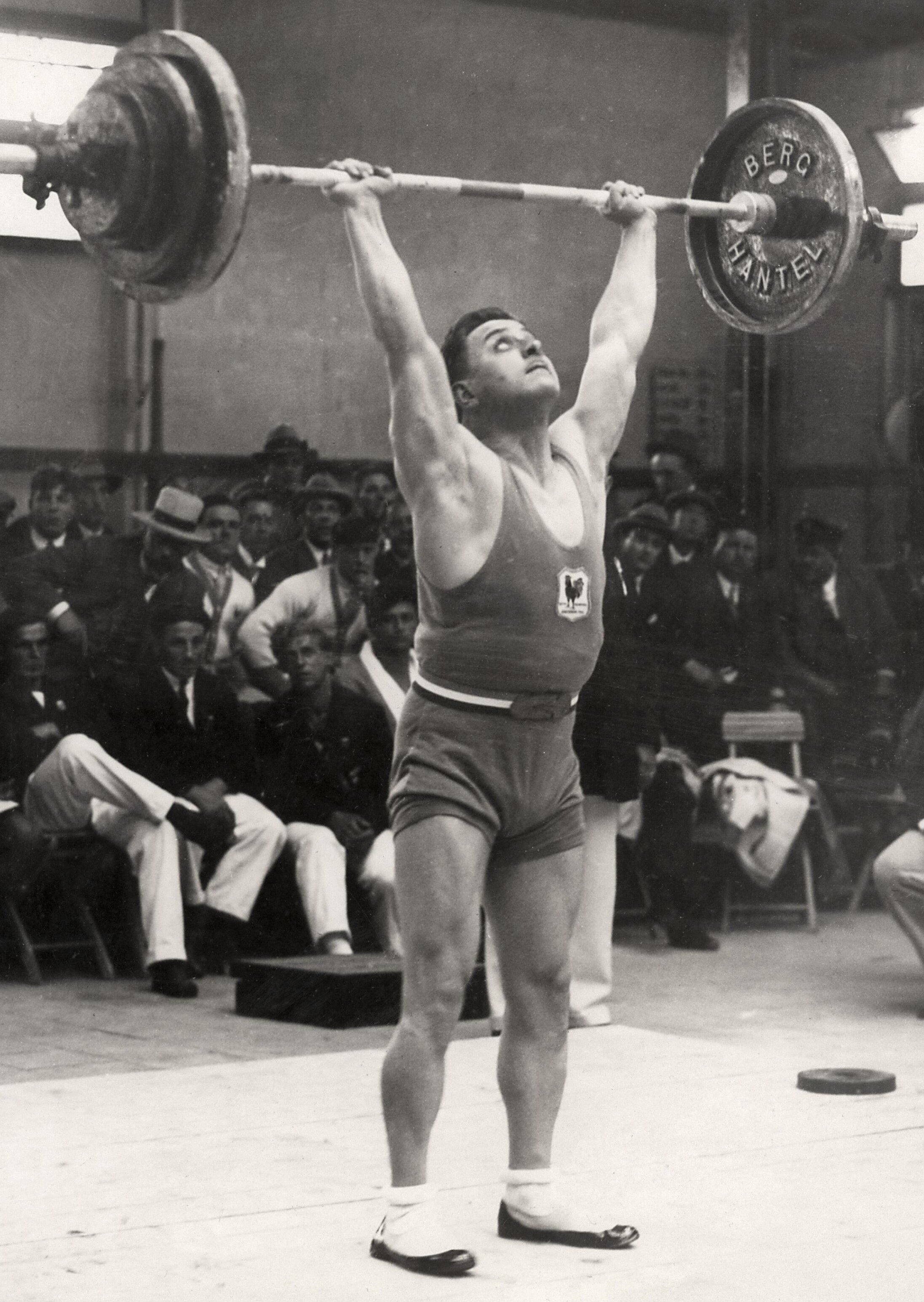
Our History
A club of pioneers…
The Société Athlétique Montmartroise—SAM for short—is one of the oldest continually open strength training clubs in the world and the oldest of its kind in France.
The club was established in 1898 by Eugène Robert, a shot-putter who had trained in the many clubs that had bloomed across Paris during the closing decade of the 19th century. Paris’s breath-taking modernity and innovation—with the Eiffel Tower dominating the horizon and the first cars taking to the streets—was paralleled by an interest in human physical potential: what else could humankind achieve? Yet while there was no shortage of Parisian clubs for those interested in strength training and physical culture, there were few universal norms and many conflicting opinions about how to get truly strong.
“In the eighteenth arrondissement, everyone knows Robert and esteems him, because Robert is not simply a sportsman, he is also a polite and amiable man who has no enemies; not only can he boast of having the esteem and friendship of his club members, but it can also be said that wherever he goes, he has always been highly regarded, thanks to his frank and open character.”
— La Culture Physique, August 1909
At the turn of the 20th century, Olympic lifting as we know it today was still in its infancy. Weightlifting and other gym equipment were unreliable in their range and quality. Robert took a scientific interest in optimised training; he invested in an unrivalled array of weights and training apparatus and brought pioneers in physical education and physical culture into the club to share their knowledge and expertise in a welcoming, friendly environment dedicated to its community in the 18th arrondissement in the north of Paris.
Who were these men?
Since its beginnings, SAM has been loyal to its community while remaining open to the world, embracing the evolution of strength sports and welcoming visiting athletes from abroad. SAM plays an important part in the history of Olympic Weightlifting. From the domain of circus strongmen and army officers, the sport became an essential base for every serious athlete of la belle epoque, whether they were gymnasts, boxers, or cyclists. By the time weightlifting became codified as an Olympic sport at the 1920 games in Antwerp, SAM had an arsenal of world-beating champions at the ready. Today, SAM boasts competitive sections for kettlebell lifting and powerlifting that complement its ongoing representation in competitive Olympic weightlifting.
Kettlebell lifting, girevoy sport or kettlebell sport, is a strength discipline first systematically developed by the Russian military in the 19th century. It is still little known outside Eastern Europe and the former Soviet republics and is notable for its popularity amongst women as much as men. The club’s president, Laurent Faucher, is the general secretary of the IUKL (the International Union of Kettlebell Lifting), and FFForce vice-president for kettlebells. In 2019 the club played host to the European youth championships and is the regular host for the annual Ile-de-France kettlebell championship.
With powerlifting enjoying a boom in France, SAM is home to a growing team of lifters, many of whom compete at the regional and national levels.
Charles Rigoulot
“The strongest man in the world…”
Sprinter, weightlifter, racing driver, and wrestler: Charles Rigoulot was a supreme sportsman who also turned his hand to singing and acting.
Charles took gold at the Paris Olympics in 1924 in the 82.5-kilo division (Light-Heavyweight). He had started out as a sprinter specialising in the 100 meters, then turned to football. It was in Olympic Weightlifting however that he found his true calling, even being nicknamed “the strongest man in the world” following victory in 1925 at the Cirque d'Hiver (11th arrondissement) over his compatriot, legendary Olympic champion, and fellow Parisien, Ernest Cadine. Rigoulot would go on to break 56 world records, including the clean and jerk with a spherical barbell weighing 185 kilos and a one-arm snatch of 116 kilos. In 1930 he made history yet again by becoming the first man to clean and jerk the mythic ‘Apollon’s Wheels’: a 166-kilo barbell made from two train wheels in 1892 to the specifications of legendary strongman, Louis Uni. Weights designed and used by Rigoulot are housed at SAM’s gymnasium today.
An injury forced Rigoulot’s retirement from strength sports in 1931, thereafter he transferring his prodigious talents to wrestling, car racing, acting, and singing. He married a gymnast, Maga Roche, and their daughter Dany Rigoulot became a French national figure-skating champion. During WWII he became a prisoner of war in Germany. The story goes that Charles helped inmates to escape by bending the bars on their holding cell window with his bare hands.
The legendary name of Charles Rigoulot has been preserved for the people of Paris in the name of a stadium and theatre at the Brancion door in Paris’s 14th arrondissement.
Gallery of the great
Jacques Bretagne
Proving that age is not a barrier to success
Proving that weightlifting and strength training can be done at any age, Jacques was one of the club’s oldest and most long-standing members, joining at the age of 21 in 1949 and remaining loyal for more than 70 years until his death in 2020 at the age of 92. Between 1995 and 2017—when he was 89—he dominated Olympic Weightlifting in the Masters’ category. A six-time world champion, he had five European championships and 19 French national championship titles to his name.
Olympians
France National Weightlifting Team, 1st October, 1927
left to right: Allemagne, Mascot, Messe, Roger François (SAM), André Rolet (SAM)

![Equipe de France_Raymond Suvigny, Fernand Arnout, Roger François, André Rolet [De_g_à_d_les_[...]Agence_Rol_btv1b531712518_1.jpeg](https://images.squarespace-cdn.com/content/v1/60620debb8cc6364b03df39a/1617045002388-VSCIBS11AQWZGLYKHFMG/Equipe+de+France_Raymond+Suvigny%2C+Fernand+Arnout%2C+Roger+Franc%CC%A7ois%2C+Andre%CC%81+Rolet+%5BDe_g_a%CC%80_d_les_%5B...%5DAgence_Rol_btv1b531712518_1.jpeg)


![Fernand Arnout [Portrait_de_l'haltérophile]_Arnoud_[i_[...]Agence_Rol_btv1b531753155_1.jpeg](https://images.squarespace-cdn.com/content/v1/60620debb8cc6364b03df39a/1618936885299-LRDFCFGGS1K4Z8A7L6HV/Fernand+Arnout+%5BPortrait_de_l%27halte%CC%81rophile%5D_Arnoud_%5Bi_%5B...%5DAgence_Rol_btv1b531753155_1.jpeg)

![André Rolet [Portrait_de_l'haltérophile_André]_Rolet_[...]Agence_Rol_btv1b531752936_1 (1).jpeg](https://images.squarespace-cdn.com/content/v1/60620debb8cc6364b03df39a/1618936883721-JE3JEPL7WLRRKX19GXAV/Andre%CC%81+Rolet+%5BPortrait_de_l%27halte%CC%81rophile_Andre%CC%81%5D_Rolet_%5B...%5DAgence_Rol_btv1b531752936_1+%281%29.jpeg)
![Fernand Arnout [Gymnase_Japy_18-3-28_championnat_de_[...]Agence_Rol_btv1b53196702w_1 (1).jpeg](https://images.squarespace-cdn.com/content/v1/60620debb8cc6364b03df39a/1618936884647-KWPQJQSKCLJTTLZ5GKN0/Fernand+Arnout+%5BGymnase_Japy_18-3-28_championnat_de_%5B...%5DAgence_Rol_btv1b53196702w_1+%281%29.jpeg)
![[Portrait_de_l'haltérophile]_Roger_François_[...]Agence_Rol_btv1b53175298f_1 (1).jpeg](https://images.squarespace-cdn.com/content/v1/60620debb8cc6364b03df39a/1618936882962-JEF47784UB58ZG2363OJ/%5BPortrait_de_l%27halte%CC%81rophile%5D_Roger_Franc%CC%A7ois_%5B...%5DAgence_Rol_btv1b53175298f_1+%281%29.jpeg)
![28_10_28_[de_g_à_d_[Louis Hostin, Roger François, Gaston le Pût ]Agence_Rol_btv1b532060910_1.jpeg](https://images.squarespace-cdn.com/content/v1/60620debb8cc6364b03df39a/1618936883064-2BUWMOL43C5WZY1O8VXO/28_10_28_%5Bde_g_a%CC%80_d_%5BLouis+Hostin%2C+Roger+Franc%CC%A7ois%2C+Gaston+le+Pu%CC%82t+%5DAgence_Rol_btv1b532060910_1.jpeg)


![Wagram_21oct1927_France_Allemagne [Mascot, Messe, Roger François, André Rolet, Dutriève]Agence_Rol_btv1b531903726_1.jpeg](https://images.squarespace-cdn.com/content/v1/60620debb8cc6364b03df39a/1617045021667-8CSOYV5WNG6IUL5NTS49/Wagram_21oct1927_France_Allemagne+%5BMascot%2C+Messe%2C+Roger+Franc%CC%A7ois%2C+Andre%CC%81+Rolet%2C+Dutrie%CC%80ve%5DAgence_Rol_btv1b531903726_1.jpeg)